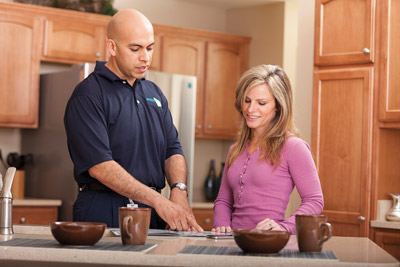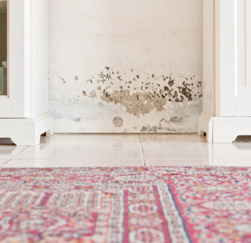 Mold vs. Mildew
Mold vs. Mildew
“Both are sort of popular names for fungus,” said Dr. Harriet Ammann. “Sort of like calling a plant a weed. There’s really no difference between mold and mildew.” They are just terms for fungi that are not mushrooms or yeast, she said.
Mold flourishes in areas that have a high humidity and are full of moisture. For the mold to spread and survive it needs to feed off of a food source such as cellulose. Common examples with that found in homes or businesses would be drywall or wood.
After natural disasters such as hurricanes, tornadoes, and floods, excess moisture and standing water contribute to the growth of mold in homes and other buildings. When returning to a home that has been flooded, be aware that mold may be present and may be a health risk for your family.
Warning Signs
- There are a few warning signs of mold to look for if you’re buying a house or renting an apartment:
- “The first thing to do is use your nose,” says Alex Heinz, a local home inspector. A strong musty smell is an indication that mold might be a problem.
- A thorough visual inspection is a good idea. Keep an eye out especially for water stains or for faucets and other fixtures that look as if they’ve had leakage problems.
- Certain spots are more likely to be breeding grounds for mold, including bathrooms, kitchens, laundry rooms, basements, attics, crawl spaces, closets and windowsills. It’s a good idea to check around washer/dryers and water heaters, too.
Beware also if a room looks and smells new. It could be an attempt to cover up recent mold problems.
Tips for your house
- Fix leaks and seepage. If water is entering the house from the outside, your options range from simple landscaping to extensive excavation and waterproofing. (The ground should slope away from the house.) Water in the basement can result from the lack of gutters or a water flow toward the house.
- Water leaks in pipes or around tubs and sinks can provide a breeding ground for mold.
- Put a plastic cover over dirt in crawlspaces to prevent moisture from coming in from the ground. Be sure crawlspaces are well ventilated.
- Use exhaust fans in bathrooms and kitchens to move moisture outside, not into the attic. Also, vent your clothes dryer to the outside.
- Turn off humidifiers or kerosene heaters if you notice moisture on windows and other surfaces.
- Raise the temperature of cold surfaces where moisture condenses. Use insulation or storm windows. (A storm window installed on the inside works better than one installed on the outside.) Open doors between rooms (especially doors to closets which may be colder than the rooms) to increase circulation.
- Circulation carries heat to the cold surfaces. Increase air circulation by using fans and by moving furniture from wall corners to promote air and heat circulation. Be sure that your house has a source of fresh air and can expel excessive moisture from the home.
- Pinpoint the source of water and get the area dry as soon as possible to prevent it in the first place. The best way to do this would be to contact ServiceMaster Advanced Restorations immediately so we can implement our 3 phase water drying process.
- The longer you wait to get rid of your mold problem, more damage can be done and your quality of living will continue to decline.
People at Greatest Risk from Mold
People with asthma, allergies, or other breathing conditions may be more sensitive to mold. People with immune suppression (such as people with HIV infection, cancer patients taking chemotherapy, and people who have received an organ transplant) are more susceptible to mold infections.
Possible Health Effects of Mold Exposure
People who are sensitive to mold may experience stuffy nose, irritated eyes, wheezing, or skin irritation. People allergic to mold may have difficulty in breathing and shortness of breath. People with weakened immune systems and with chronic lung diseases, such as obstructive lung disease, may develop mold infections in their lungs. If you or your family members have health problems after exposure to mold, contact your doctor or other health care provider.
Recognizing Mold
You may recognize mold by:
- Sight (Are the walls and ceiling discolored, or do they show signs of mold growth or water damage?)
- Smell (Do you smell a bad odor, such as a musty, earthy smell or a foul stench?)
 Safely Preventing Mold Growth
Safely Preventing Mold Growth
- Call ServiceMaster Advanced Restorations @ 817-267-5555 to start the drying process. Do not take the risk of improperly drying your home or business and cause mold damage.
- If there is mold growth in your home, you should have the mold cleaned or removed and fix any water problem, such as leaks in roofs, walls or plumbing. Controlling moisture in your home is the most critical factor for preventing mold growth.
- For wide spread exposure, contact us to ensure that the mold is removed properly without the risk of cross-contamintating other ares of your home or business.
